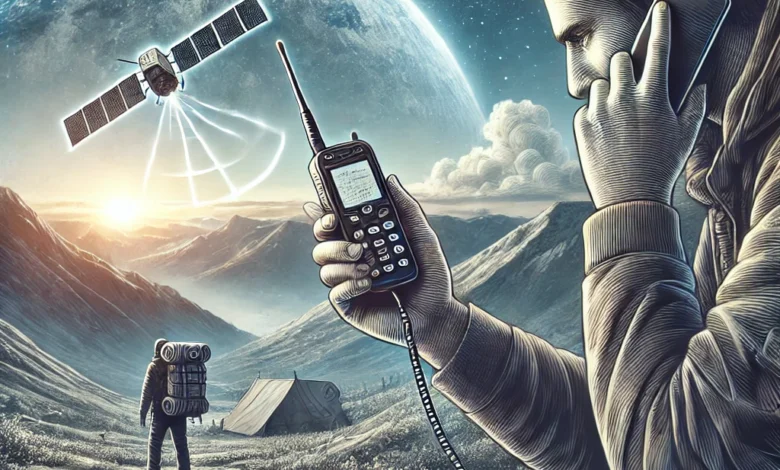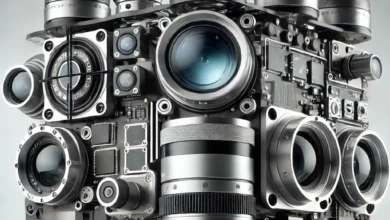Satellite Phones: A Vital Tool for Emergency Communication

Introduction
When disaster strikes, communication can mean the difference between life and death. Whether you’re caught in a natural disaster, navigating a remote wilderness, or dealing with a global crisis, the ability to communicate quickly and reliably is essential. Unfortunately, traditional communication systems often fail at the most critical moments, leaving people stranded without a lifeline.
This is where satellite phones come into play. Satellite phones have proven themselves to be a vital tool for emergency communication. Their ability to function independently of local infrastructure makes them a reliable solution when cell towers are down or there is no service. Whether you’re an adventurer, a first responder, or simply someone who wants to stay prepared, understanding the importance of satellite phones can make all the difference in a crisis.
What Are Satellite Phones?
A satellite phone, commonly referred to as a “sat phone,” is a type of mobile phone that communicates directly with satellites instead of relying on cell towers. These devices connect to satellites orbiting the Earth, enabling users to make voice calls, send texts, or transmit data even in the most remote corners of the globe.
Unlike traditional mobile phones, which require proximity to cell towers, satellite phones only need a clear line of sight to a satellite. This makes them invaluable for anyone traveling to or living in areas with poor or nonexistent cellular coverage. Whether you’re in the middle of a dense forest, on a faraway island, or at the summit of a mountain, a satellite phone ensures you’re never out of reach.
Visit https://www.outdoortechlab.com/satellite-phones-mobile/
How Satellite Phones Work
Satellite phones operate by transmitting signals to satellites in space, which then relay those signals to Earth-based receivers. Unlike cell phones, which communicate through a network of towers that cover specific regions, satellite phones bypass this infrastructure entirely. Depending on the network they use, satellite phones connect either to Low-Earth Orbit (LEO) satellites or Geostationary (GEO) satellites.
- LEO Satellites: These satellites orbit relatively close to the Earth’s surface and provide more extensive coverage by moving across different regions. LEO satellite phones often have faster connection times due to their proximity to the planet.
- GEO Satellites: These satellites remain in a fixed position relative to the Earth, providing consistent coverage over a specific area. GEO satellite phones are ideal for users who need reliable coverage in a particular region.
Regardless of the type of satellite network used, satellite phones provide coverage in remote areas where traditional communication systems falter.
Key Benefits of Using Satellite Phones in Emergencies
One of the most significant advantages of satellite phones is their ability to function during emergencies when other communication methods fail. Here are a few key benefits:
- Reliable Communication: Unlike cell phones, satellite phones don’t rely on terrestrial infrastructure like cell towers, making them immune to damage from natural disasters, power outages, or other disruptions.
- Global Coverage: Satellite phones provide coverage in areas where mobile phones are useless, such as deep wilderness, oceans, deserts, and high altitudes.
- Durability: Satellite phones are designed for rugged environments. They are built to withstand extreme weather conditions, making them essential for emergency responders, adventurers, and military personnel.
In emergency situations, the durability and reliability of satellite phones can be lifesaving. They ensure that communication remains possible even in the most challenging conditions.
Watch the following video :
Applications of Satellite Phones in Emergency Situations
Satellite phones have proven their worth time and time again in real-world emergency situations. Here are a few common scenarios where satellite phones become indispensable:
- Natural Disasters: In the aftermath of earthquakes, hurricanes, or floods, terrestrial communication networks often collapse. Satellite phones offer a reliable way for survivors, rescue teams, and aid organizations to communicate and coordinate relief efforts.
- Remote Rescue Operations: When someone is lost in a remote wilderness or stranded in a desert, satellite phones allow rescue teams to communicate across vast distances without relying on ground-based infrastructure.
- Humanitarian Aid and Disaster Relief: During large-scale disasters, humanitarian organizations use satellite phones to coordinate efforts, distribute resources, and communicate with isolated communities.
- Military and Government Use: In conflict zones or regions with limited infrastructure, satellite phones enable critical communication for military operations, diplomatic efforts, and government emergency services.
In each of these scenarios, the ability to maintain reliable communication makes satellite phones a lifeline.
Satellite Phones vs. Other Emergency Communication Tools
Many people rely on various tools for emergency communication, such as walkie-talkies, CB radios, or even mobile phones with offline messaging apps. However, these tools have limitations that satellite phones easily overcome:
- Walkie-Talkies and Radios: These devices are excellent for short-range communication but lack the ability to reach distant areas or connect with emergency services far away.
- Mobile Phones: Mobile phones are often the first to fail during disasters due to damaged cell towers or overloaded networks. Without satellite capabilities, mobile phones become useless in remote locations or when networks go down.
Satellite phones, by contrast, provide long-distance, global communication regardless of local conditions. Their ability to function independently of any ground infrastructure makes them superior for emergencies in remote areas or during network outages.
The Role of Satellite Phones in Natural Disasters
In some of the world’s most devastating natural disasters, satellite phones have played a crucial role in saving lives and coordinating relief efforts. Take, for example, the 2010 earthquake in Haiti, where much of the country’s infrastructure collapsed. Emergency responders relied on satellite phones to communicate with international aid organizations, coordinate search-and-rescue missions, and manage supply distribution.
Similarly, in the aftermath of hurricanes, such as Katrina in 2005, satellite phones provided a communication lifeline when cell towers and landlines were rendered useless. These examples highlight the vital role that satellite phones play in disaster preparedness and response.
Satellite Phones for Wilderness Adventures and Extreme Sports
For adventurers, explorers, and extreme sports enthusiasts, satellite phones are an essential tool for staying safe in remote or dangerous locations. Whether you’re mountaineering in the Himalayas, sailing across the Pacific, or trekking through the Sahara, traditional communication methods often don’t work.
Satellite phones allow adventurers to stay connected, whether they’re checking in with loved ones, receiving weather updates, or calling for help in an emergency. With a satellite phone in hand, you can take comfort in knowing that you’re never completely cut off from civilization.
The Importance of Satellite Phones for International Travelers
When traveling to regions with unreliable or nonexistent infrastructure, having a satellite phone can be the key to staying safe. International travelers often find themselves in situations where local communication networks are unreliable or simply don’t exist.
For example, in remote parts of Africa, South America, or Asia, a satellite phone can be the only way to call for help if something goes wrong. Whether you’re traveling for business, research, or adventure, carrying a satellite phone ensures that you can always connect with emergency services or loved ones back home.
How to Use a Satellite Phone in an Emergency
Using a satellite phone in an emergency is relatively simple, but there are a few best practices to ensure a reliable connection:
- Positioning: Make sure you’re in an open area with a clear view of the sky. Buildings, trees, and mountains can obstruct your phone’s connection to satellites.
- Turning On the Device: Turn on the satellite phone and extend its antenna for maximum signal reception.
- Dialing: Dial the emergency number or the contact you’re trying to reach, just like you would on a regular phone.
- Conserving Battery Life: In an extended emergency, it’s crucial to conserve battery life. Turn the phone off when not in use and avoid unnecessary calls.
- Maintaining the Signal: Be mindful of your environment. If you lose connection, reposition yourself in a different location for a better signal.
By following these steps, you can maximize the effectiveness of your satellite phone during an emergency.
Key Features of a Good Satellite Phone
When choosing a satellite phone, especially for emergency purposes, it’s essential to consider a few critical features:
- Ruggedness: Look for a phone that can withstand harsh environments, including extreme temperatures, water exposure, and rough handling.
- Battery Life: Long battery life is crucial in emergency situations where recharging may not be an option.
- Ease of Use: In stressful situations, you want a phone that’s easy to operate, even for those unfamiliar with satellite communication.
How Satellite Phones Are Transforming Disaster Response
Satellite phones are increasingly being integrated into coordinated disaster response efforts worldwide. From search-and-rescue missions to disaster relief, satellite communication allows first responders and aid organizations to communicate across vast distances and difficult terrain.
During large-scale emergencies, satellite phones enable responders to communicate with isolated communities, coordinate resources, and track the progress of relief operations in real time. This level of communication has significantly improved the efficiency and effectiveness of disaster response efforts.
Myths and Misconceptions About Satellite Phones
Despite their proven utility, there are still many myths and misconceptions surrounding satellite phones. Let’s debunk a few of them:
- Myth: Satellite phones are unreliable in bad weather.Fact: While some environmental factors can affect satellite signals, modern satellite phones are designed to function in most weather conditions.
- Myth: Satellite phones are too expensive for the average person.Fact: While satellite phones used to be costly, there are now affordable options, and renting a satellite phone for short-term use is also possible.
- Myth: Satellite phones are only for government or military use.Fact: Satellite phones are accessible to anyone, including adventurers, travelers, and even everyday citizens looking to prepare for emergencies.
Satellite Phone Cost and Accessibility
Many people are hesitant to invest in satellite phones because of concerns about cost. However, the price of satellite phones has become more affordable in recent years, and there are options for renting a phone if you only need one for a short time.
Consider it this way: investing in a satellite phone is investing in your safety and peace of mind. In situations where traditional communication fails, a satellite phone is worth its weight in gold.
Conclusion
Satellite phones have become an essential tool for emergency communication, providing reliable, global coverage in situations where other communication methods fall short. Whether you’re preparing for a natural disaster, heading out on a wilderness adventure, or traveling to remote parts of the world, a satellite phone is your lifeline to safety.
The reliability, durability, and versatility of satellite phones make them a must-have for anyone concerned about emergency preparedness. In today’s unpredictable world, staying connected has never been more critical. With a satellite phone, you’re not just preparing for the unexpected—you’re ensuring that, no matter what happens, help is just a phone call away.
FAQs
- How do satellite phones differ from regular mobile phones? Satellite phones connect to satellites orbiting the Earth, providing coverage in remote areas where cell phones don’t work. They don’t rely on cell towers.
- Can satellite phones work during extreme weather conditions? Yes, satellite phones are designed to function in a wide range of weather conditions, though heavy storms may occasionally affect signal strength.
- Are satellite phones expensive? While satellite phones were once expensive, their prices have become more affordable. Renting options are available for short-term needs.
- Do satellite phones work everywhere? Satellite phones provide global coverage, but the extent may depend on the satellite network. They work in areas without cell service, including oceans and wilderness.
- Are satellite phones easy to use? Yes, satellite phones are user-friendly, with interfaces similar to mobile phones. Even in high-stress situations, they are simple to operate.

